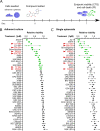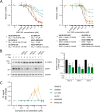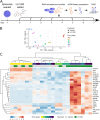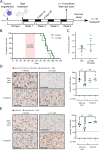PRMT5 inhibition shows in vitro efficacy against H3K27M-altered diffuse midline glioma, but does not extend survival in vivo
- PMID: 38172189
- PMCID: PMC10764357
- DOI: 10.1038/s41598-023-48652-x
PRMT5 inhibition shows in vitro efficacy against H3K27M-altered diffuse midline glioma, but does not extend survival in vivo
Abstract
H3K27-altered Diffuse Midline Glioma (DMG) is a universally fatal paediatric brainstem tumour. The prevalent driver mutation H3K27M creates a unique epigenetic landscape that may also establish therapeutic vulnerabilities to epigenetic inhibitors. However, while HDAC, EZH2 and BET inhibitors have proven somewhat effective in pre-clinical models, none have translated into clinical benefit due to either poor blood-brain barrier penetration, lack of efficacy or toxicity. Thus, there remains an urgent need for new DMG treatments. Here, we performed wider screening of an epigenetic inhibitor library and identified inhibitors of protein arginine methyltransferases (PRMTs) among the top hits reducing DMG cell viability. Two of the most effective inhibitors, LLY-283 and GSK591, were targeted against PRMT5 using distinct binding mechanisms and reduced the viability of a subset of DMG cells expressing wild-type TP53 and mutant ACVR1. RNA-sequencing and phenotypic analyses revealed that LLY-283 could reduce the viability, clonogenicity and invasion of DMG cells in vitro, representing three clinically important phenotypes, but failed to prolong survival in an orthotopic xenograft model. Together, these data show the challenges of DMG treatment and highlight PRMT5 inhibitors for consideration in future studies of combination treatments.
© 2023. Crown.
Conflict of interest statement
The authors declare no competing interests.
Figures








Similar articles
-
H3K27-Altered Diffuse Midline Glioma of the Brainstem: From Molecular Mechanisms to Targeted Interventions.Cells. 2024 Jun 28;13(13):1122. doi: 10.3390/cells13131122. Cells. 2024. PMID: 38994974 Free PMC article. Review.
-
STAT3 is a biologically relevant therapeutic target in H3K27M-mutant diffuse midline glioma.Neuro Oncol. 2022 Oct 3;24(10):1700-1711. doi: 10.1093/neuonc/noac093. Neuro Oncol. 2022. PMID: 35397475 Free PMC article.
-
Real-time drug testing of paediatric diffuse midline glioma to support clinical decision making: The Zurich DIPG/DMG centre experience.Eur J Cancer. 2023 Jan;178:171-179. doi: 10.1016/j.ejca.2022.10.014. Epub 2022 Oct 26. Eur J Cancer. 2023. PMID: 36455411
-
H3K27M diffuse midline glioma is homologous recombination defective and sensitized to radiotherapy and NK cell-mediated antitumor immunity by PARP inhibition.bioRxiv [Preprint]. 2024 Aug 27:2024.08.26.609803. doi: 10.1101/2024.08.26.609803. bioRxiv. 2024. Update in: Neuro Oncol. 2025 Apr 10:noaf097. doi: 10.1093/neuonc/noaf097. PMID: 39253432 Free PMC article. Updated. Preprint.
-
Therapeutic avenues for targeting treatment challenges of diffuse midline gliomas.Neoplasia. 2023 Jun;40:100899. doi: 10.1016/j.neo.2023.100899. Epub 2023 Apr 6. Neoplasia. 2023. PMID: 37030112 Free PMC article. Review.
Cited by
-
H3K27-Altered Diffuse Midline Glioma of the Brainstem: From Molecular Mechanisms to Targeted Interventions.Cells. 2024 Jun 28;13(13):1122. doi: 10.3390/cells13131122. Cells. 2024. PMID: 38994974 Free PMC article. Review.
-
PRMT5 Maintains Tumor Stem Cells to Promote Pediatric High-Grade Glioma Tumorigenesis.Mol Cancer Res. 2025 Feb 6;23(2):107-118. doi: 10.1158/1541-7786.MCR-24-0233. Mol Cancer Res. 2025. PMID: 39422546 Free PMC article.
-
Establishment of xenografts and methods to evaluate tumor burden for the three most frequent subclasses of pediatric-type diffuse high grade gliomas.J Neurooncol. 2025 May;172(3):599-611. doi: 10.1007/s11060-025-04954-w. Epub 2025 Feb 17. J Neurooncol. 2025. PMID: 39961939 Free PMC article.
References
-
- Pritchard-Jones K. Childhood cancer in Britain: Incidence, survival and mortality. Br. J. Cancer. 2007;96(12):1927. doi: 10.1038/SJ.BJC.6603800. - DOI
MeSH terms
Substances
Grants and funding
LinkOut - more resources
Full Text Sources
Medical
Molecular Biology Databases
Research Materials
Miscellaneous

